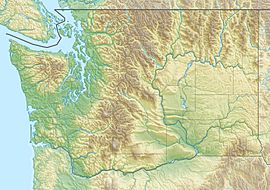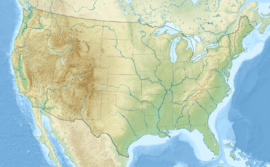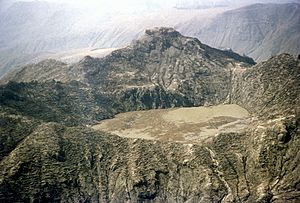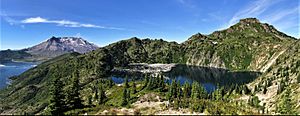Coldwater Peak facts for kids
Quick facts for kids Coldwater Peak |
|
|---|---|
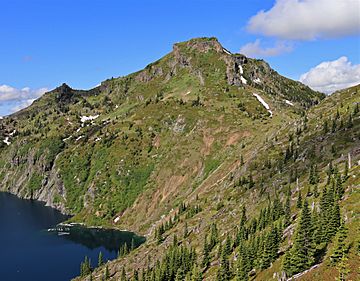
Northeast aspect, above Saint Helens Lake
|
|
| Highest point | |
| Elevation | 5,722 ft (1,744 m) |
| Prominence | 720 ft (220 m) |
| Isolation | 2.41 mi (3.88 km) |
| Parent peak | Mount Margaret (5,860 ft) |
| Geography | |
| Location | Mount St. Helens National Volcanic Monument Skamania County, Washington, U.S. |
| Parent range | Cascade Range |
| Topo map | USGS Spirit Lake West |
| Geology | |
| Type of rock | Tertiary volcanic rock |
| Volcanic arc | Cascade Volcanic Arc |
| Climbing | |
| Easiest route | Hiking trail |
Coldwater Peak is a mountain in Washington state, standing at 5,722 ft (1,740 m). It's found within the Mount St. Helens National Volcanic Monument. This peak is part of the Cascade Range. It's about 2 mi (3.2 km) northwest of Spirit Lake. Mount St. Helens is also nearby, about 7 mi (11 km) to the south.
Water from Coldwater Peak flows into Coldwater Creek. This creek then joins the North Fork Toutle River. The mountain was named after Coldwater Creek. The name was officially recognized in 1983. There is a hiking trail to the top of the peak. This spot used to be a fire lookout from 1935 to 1968. Today, it's used for scientific research.
How Coldwater Peak Was Formed
The Cascade Range formed millions of years ago. This happened during the late Eocene Epoch. Over time, many geological events shaped the land. These events created the tall mountains and deep valleys we see today. They also led to different climates across the region.
About two million years ago, during the Pleistocene period, glaciers played a big role. These huge ice sheets moved forward and backward many times. They carved out the landscape, making it what it is now. The North American Plate is slowly moving over the Pacific Plate. This movement caused volcanoes to erupt.
A major event for Coldwater Peak was the 1980 eruption of Mount St. Helens. The powerful side blast from this eruption hit Coldwater Peak directly. It stripped away all the trees and plants from its slopes. Because Mount St. Helens is so close, you can find a lot of volcanic ash in this area.
Weather Around Coldwater Peak
Coldwater Peak is in a marine west coast climate zone. This means it gets a lot of moisture from the Pacific Ocean. Most weather systems start over the Pacific. They then move northeast towards the Cascade Range.
When these weather systems reach the mountains, they are forced to rise. This process is called Orographic lift. As the air rises, it cools down and drops its moisture. This causes a lot of rain or snow to fall on the western side of the Cascades. Winters here are usually cloudy and wet.
However, during the summer, high-pressure systems form over the Pacific. These systems often bring clear skies. This means July, August, and September are usually the best months. The weather is good for hiking or just enjoying the views of Coldwater Peak.


